Project: Impact of Reward System on Staff Performance at Tesco
VerifiedAdded on 2020/10/22
|41
|9306
|189
Project
AI Summary
This project investigates the impact of reward systems on staff performance, using Tesco as a case study. The introduction outlines the significance of reward systems within Tesco, defining the research aim, objectives, and questions, and providing a chapter structure. The literature review explores the concept of reward systems, their importance, and different types, examining the relationship between rewards and employee performance. The research methodology, data analysis, and discussion sections are also included, along with recommendations and a conclusion. The project highlights the importance of rewards in motivating employees, improving performance, and increasing employee loyalty. It explores the impact of financial and non-financial rewards and how Tesco utilizes them to boost staff performance. The research aims to identify the impact of various rewards on employee's performance and analyzing the effectiveness of current reward system in organization in raising employee’s performance.
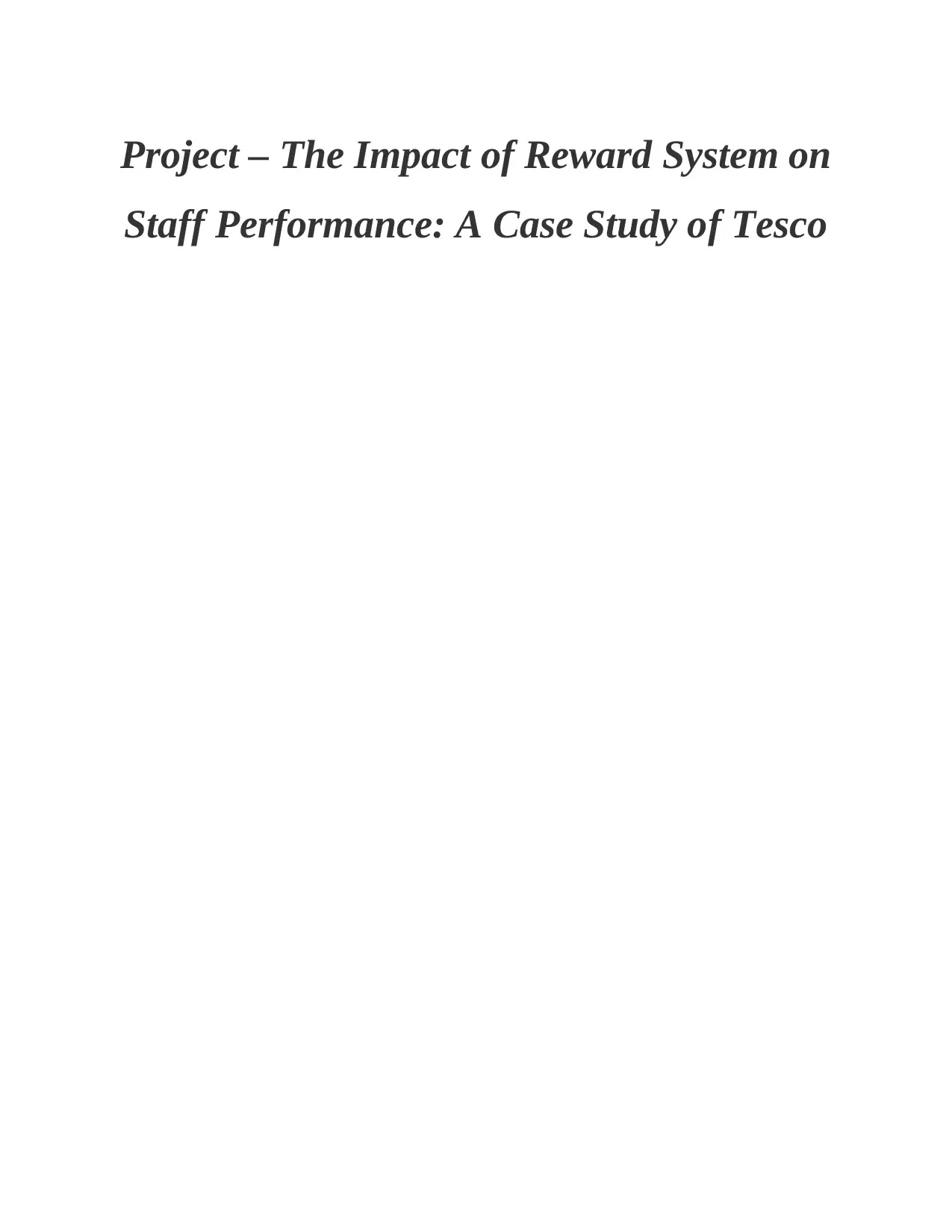
Project – The Impact of Reward System on
Staff Performance: A Case Study of Tesco
Staff Performance: A Case Study of Tesco
Paraphrase This Document
Need a fresh take? Get an instant paraphrase of this document with our AI Paraphraser
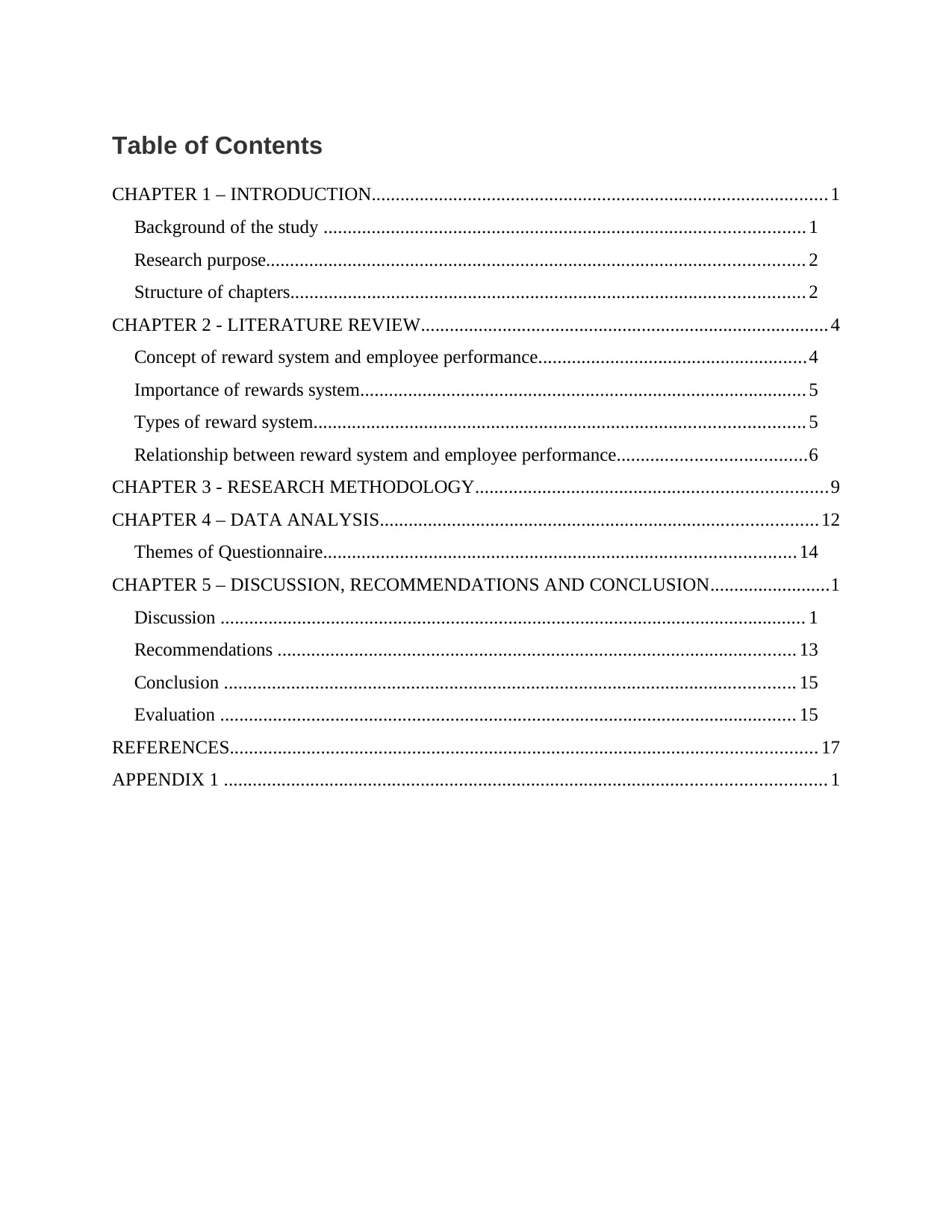
Table of Contents
CHAPTER 1 – INTRODUCTION............................................................................................... 1
Background of the study .................................................................................................... 1
Research purpose................................................................................................................ 2
Structure of chapters........................................................................................................... 2
CHAPTER 2 - LITERATURE REVIEW..................................................................................... 4
Concept of reward system and employee performance........................................................4
Importance of rewards system............................................................................................. 5
Types of reward system...................................................................................................... 5
Relationship between reward system and employee performance.......................................6
CHAPTER 3 - RESEARCH METHODOLOGY.........................................................................9
CHAPTER 4 – DATA ANALYSIS........................................................................................... 12
Themes of Questionnaire.................................................................................................. 14
CHAPTER 5 – DISCUSSION, RECOMMENDATIONS AND CONCLUSION.........................1
Discussion .......................................................................................................................... 1
Recommendations ............................................................................................................ 13
Conclusion ....................................................................................................................... 15
Evaluation ........................................................................................................................ 15
REFERENCES.......................................................................................................................... 17
APPENDIX 1 ............................................................................................................................. 1
CHAPTER 1 – INTRODUCTION............................................................................................... 1
Background of the study .................................................................................................... 1
Research purpose................................................................................................................ 2
Structure of chapters........................................................................................................... 2
CHAPTER 2 - LITERATURE REVIEW..................................................................................... 4
Concept of reward system and employee performance........................................................4
Importance of rewards system............................................................................................. 5
Types of reward system...................................................................................................... 5
Relationship between reward system and employee performance.......................................6
CHAPTER 3 - RESEARCH METHODOLOGY.........................................................................9
CHAPTER 4 – DATA ANALYSIS........................................................................................... 12
Themes of Questionnaire.................................................................................................. 14
CHAPTER 5 – DISCUSSION, RECOMMENDATIONS AND CONCLUSION.........................1
Discussion .......................................................................................................................... 1
Recommendations ............................................................................................................ 13
Conclusion ....................................................................................................................... 15
Evaluation ........................................................................................................................ 15
REFERENCES.......................................................................................................................... 17
APPENDIX 1 ............................................................................................................................. 1
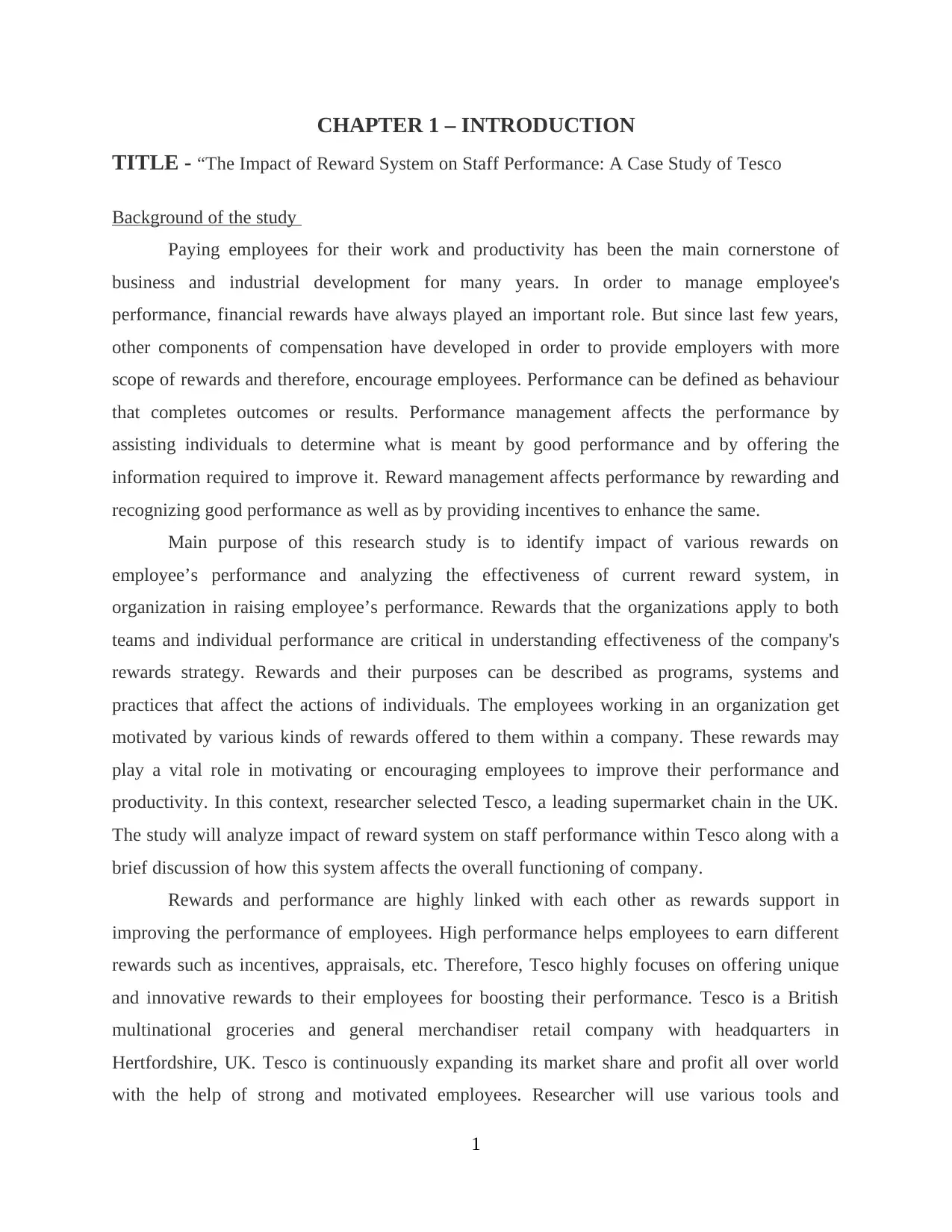
CHAPTER 1 – INTRODUCTION
TITLE - “The Impact of Reward System on Staff Performance: A Case Study of Tesco
Background of the study
Paying employees for their work and productivity has been the main cornerstone of
business and industrial development for many years. In order to manage employee's
performance, financial rewards have always played an important role. But since last few years,
other components of compensation have developed in order to provide employers with more
scope of rewards and therefore, encourage employees. Performance can be defined as behaviour
that completes outcomes or results. Performance management affects the performance by
assisting individuals to determine what is meant by good performance and by offering the
information required to improve it. Reward management affects performance by rewarding and
recognizing good performance as well as by providing incentives to enhance the same.
Main purpose of this research study is to identify impact of various rewards on
employee’s performance and analyzing the effectiveness of current reward system, in
organization in raising employee’s performance. Rewards that the organizations apply to both
teams and individual performance are critical in understanding effectiveness of the company's
rewards strategy. Rewards and their purposes can be described as programs, systems and
practices that affect the actions of individuals. The employees working in an organization get
motivated by various kinds of rewards offered to them within a company. These rewards may
play a vital role in motivating or encouraging employees to improve their performance and
productivity. In this context, researcher selected Tesco, a leading supermarket chain in the UK.
The study will analyze impact of reward system on staff performance within Tesco along with a
brief discussion of how this system affects the overall functioning of company.
Rewards and performance are highly linked with each other as rewards support in
improving the performance of employees. High performance helps employees to earn different
rewards such as incentives, appraisals, etc. Therefore, Tesco highly focuses on offering unique
and innovative rewards to their employees for boosting their performance. Tesco is a British
multinational groceries and general merchandiser retail company with headquarters in
Hertfordshire, UK. Tesco is continuously expanding its market share and profit all over world
with the help of strong and motivated employees. Researcher will use various tools and
1
TITLE - “The Impact of Reward System on Staff Performance: A Case Study of Tesco
Background of the study
Paying employees for their work and productivity has been the main cornerstone of
business and industrial development for many years. In order to manage employee's
performance, financial rewards have always played an important role. But since last few years,
other components of compensation have developed in order to provide employers with more
scope of rewards and therefore, encourage employees. Performance can be defined as behaviour
that completes outcomes or results. Performance management affects the performance by
assisting individuals to determine what is meant by good performance and by offering the
information required to improve it. Reward management affects performance by rewarding and
recognizing good performance as well as by providing incentives to enhance the same.
Main purpose of this research study is to identify impact of various rewards on
employee’s performance and analyzing the effectiveness of current reward system, in
organization in raising employee’s performance. Rewards that the organizations apply to both
teams and individual performance are critical in understanding effectiveness of the company's
rewards strategy. Rewards and their purposes can be described as programs, systems and
practices that affect the actions of individuals. The employees working in an organization get
motivated by various kinds of rewards offered to them within a company. These rewards may
play a vital role in motivating or encouraging employees to improve their performance and
productivity. In this context, researcher selected Tesco, a leading supermarket chain in the UK.
The study will analyze impact of reward system on staff performance within Tesco along with a
brief discussion of how this system affects the overall functioning of company.
Rewards and performance are highly linked with each other as rewards support in
improving the performance of employees. High performance helps employees to earn different
rewards such as incentives, appraisals, etc. Therefore, Tesco highly focuses on offering unique
and innovative rewards to their employees for boosting their performance. Tesco is a British
multinational groceries and general merchandiser retail company with headquarters in
Hertfordshire, UK. Tesco is continuously expanding its market share and profit all over world
with the help of strong and motivated employees. Researcher will use various tools and
1
⊘ This is a preview!⊘
Do you want full access?
Subscribe today to unlock all pages.

Trusted by 1+ million students worldwide
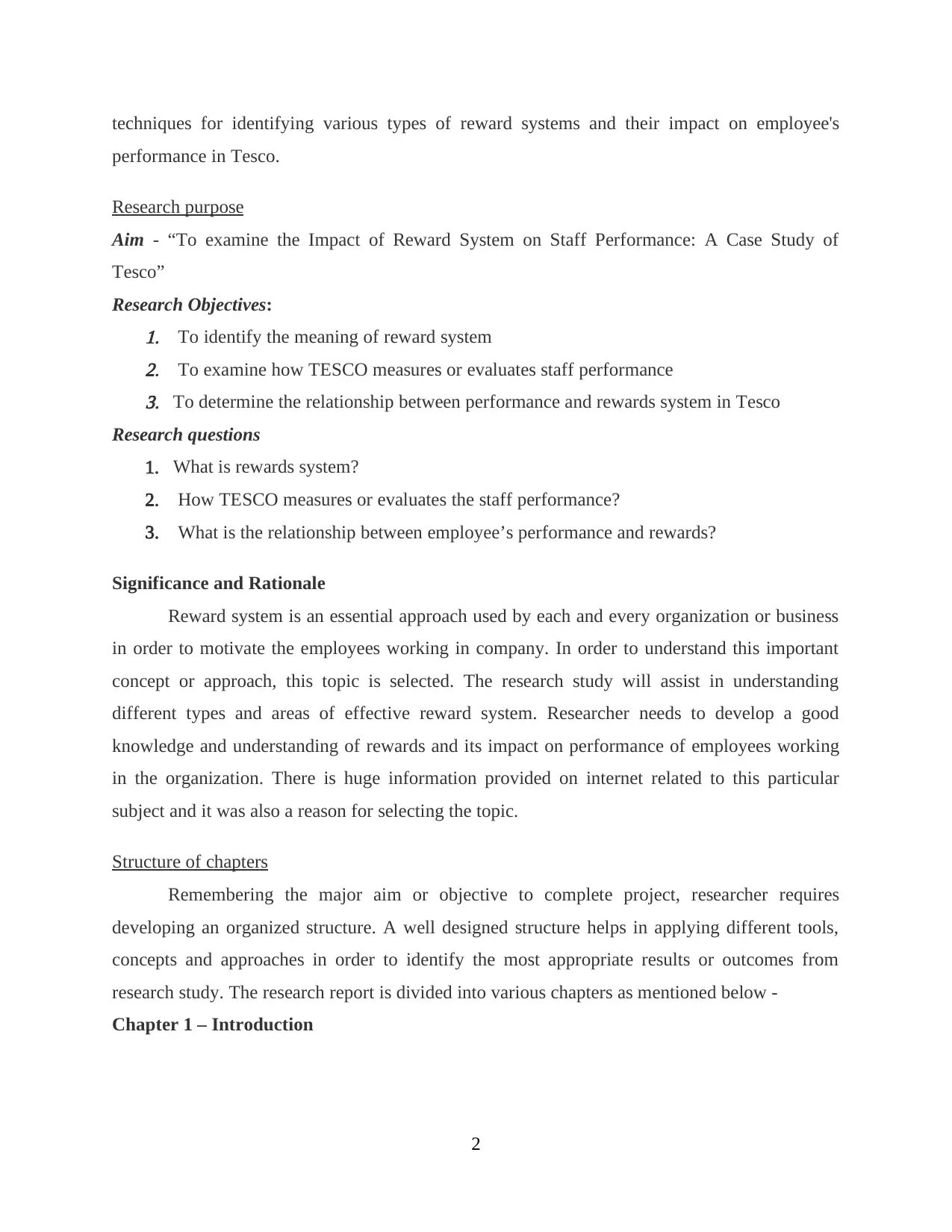
techniques for identifying various types of reward systems and their impact on employee's
performance in Tesco.
Research purpose
Aim - “To examine the Impact of Reward System on Staff Performance: A Case Study of
Tesco”
Research Objectives:1. To identify the meaning of reward system2. To examine how TESCO measures or evaluates staff performance3. To determine the relationship between performance and rewards system in Tesco
Research questions
1. What is rewards system?
2. How TESCO measures or evaluates the staff performance?
3. What is the relationship between employee’s performance and rewards?
Significance and Rationale
Reward system is an essential approach used by each and every organization or business
in order to motivate the employees working in company. In order to understand this important
concept or approach, this topic is selected. The research study will assist in understanding
different types and areas of effective reward system. Researcher needs to develop a good
knowledge and understanding of rewards and its impact on performance of employees working
in the organization. There is huge information provided on internet related to this particular
subject and it was also a reason for selecting the topic.
Structure of chapters
Remembering the major aim or objective to complete project, researcher requires
developing an organized structure. A well designed structure helps in applying different tools,
concepts and approaches in order to identify the most appropriate results or outcomes from
research study. The research report is divided into various chapters as mentioned below -
Chapter 1 – Introduction
2
performance in Tesco.
Research purpose
Aim - “To examine the Impact of Reward System on Staff Performance: A Case Study of
Tesco”
Research Objectives:1. To identify the meaning of reward system2. To examine how TESCO measures or evaluates staff performance3. To determine the relationship between performance and rewards system in Tesco
Research questions
1. What is rewards system?
2. How TESCO measures or evaluates the staff performance?
3. What is the relationship between employee’s performance and rewards?
Significance and Rationale
Reward system is an essential approach used by each and every organization or business
in order to motivate the employees working in company. In order to understand this important
concept or approach, this topic is selected. The research study will assist in understanding
different types and areas of effective reward system. Researcher needs to develop a good
knowledge and understanding of rewards and its impact on performance of employees working
in the organization. There is huge information provided on internet related to this particular
subject and it was also a reason for selecting the topic.
Structure of chapters
Remembering the major aim or objective to complete project, researcher requires
developing an organized structure. A well designed structure helps in applying different tools,
concepts and approaches in order to identify the most appropriate results or outcomes from
research study. The research report is divided into various chapters as mentioned below -
Chapter 1 – Introduction
2
Paraphrase This Document
Need a fresh take? Get an instant paraphrase of this document with our AI Paraphraser
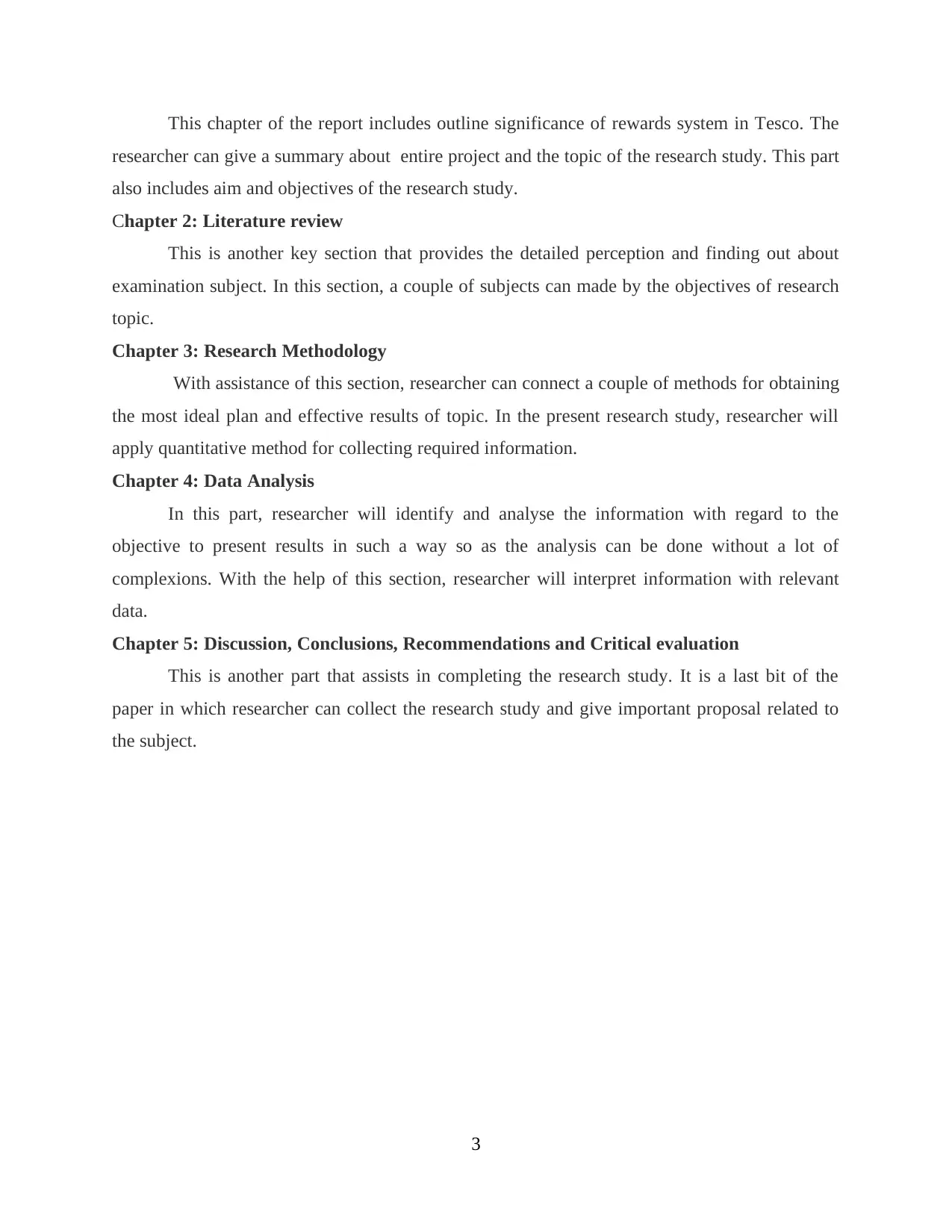
This chapter of the report includes outline significance of rewards system in Tesco. The
researcher can give a summary about entire project and the topic of the research study. This part
also includes aim and objectives of the research study.
Chapter 2: Literature review
This is another key section that provides the detailed perception and finding out about
examination subject. In this section, a couple of subjects can made by the objectives of research
topic.
Chapter 3: Research Methodology
With assistance of this section, researcher can connect a couple of methods for obtaining
the most ideal plan and effective results of topic. In the present research study, researcher will
apply quantitative method for collecting required information.
Chapter 4: Data Analysis
In this part, researcher will identify and analyse the information with regard to the
objective to present results in such a way so as the analysis can be done without a lot of
complexions. With the help of this section, researcher will interpret information with relevant
data.
Chapter 5: Discussion, Conclusions, Recommendations and Critical evaluation
This is another part that assists in completing the research study. It is a last bit of the
paper in which researcher can collect the research study and give important proposal related to
the subject.
3
researcher can give a summary about entire project and the topic of the research study. This part
also includes aim and objectives of the research study.
Chapter 2: Literature review
This is another key section that provides the detailed perception and finding out about
examination subject. In this section, a couple of subjects can made by the objectives of research
topic.
Chapter 3: Research Methodology
With assistance of this section, researcher can connect a couple of methods for obtaining
the most ideal plan and effective results of topic. In the present research study, researcher will
apply quantitative method for collecting required information.
Chapter 4: Data Analysis
In this part, researcher will identify and analyse the information with regard to the
objective to present results in such a way so as the analysis can be done without a lot of
complexions. With the help of this section, researcher will interpret information with relevant
data.
Chapter 5: Discussion, Conclusions, Recommendations and Critical evaluation
This is another part that assists in completing the research study. It is a last bit of the
paper in which researcher can collect the research study and give important proposal related to
the subject.
3
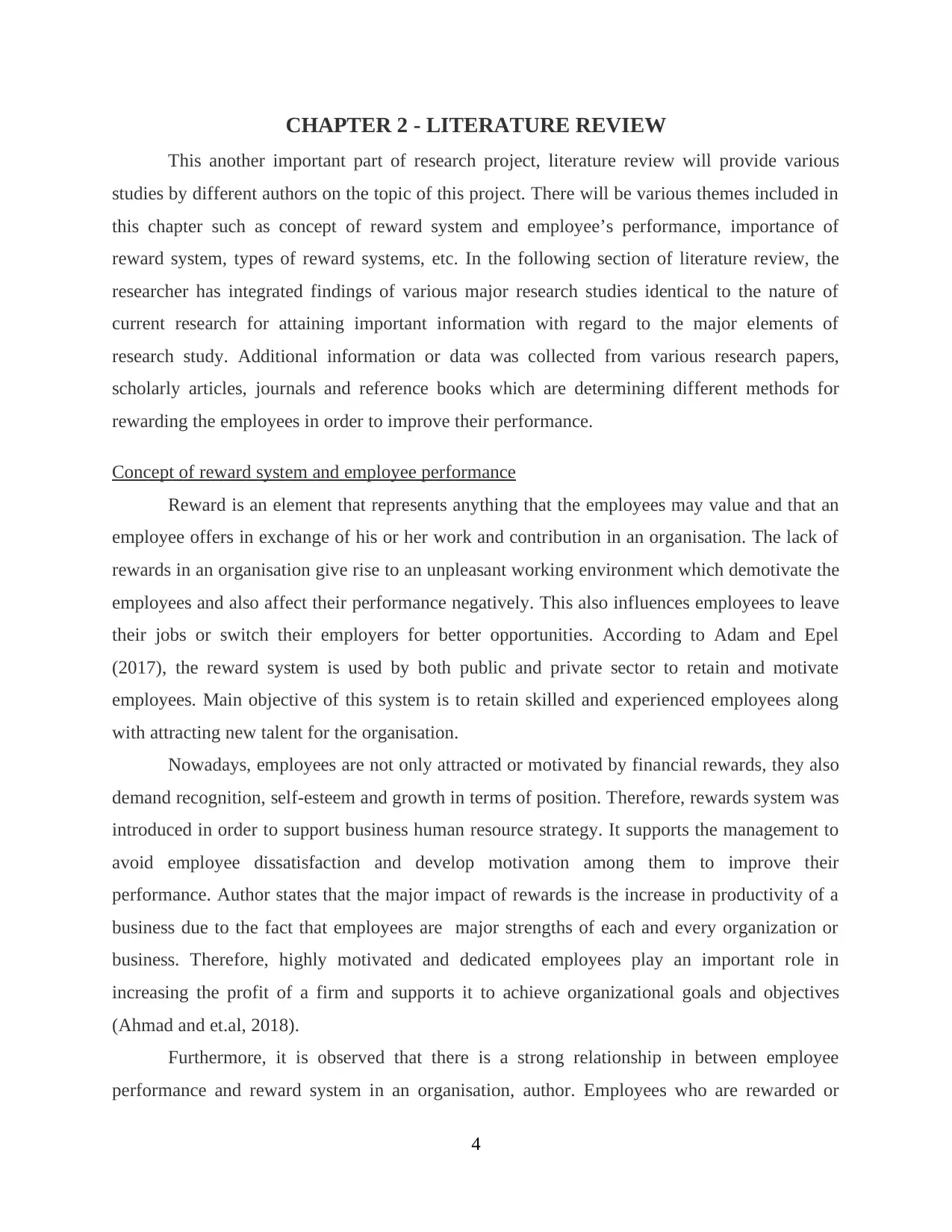
CHAPTER 2 - LITERATURE REVIEW
This another important part of research project, literature review will provide various
studies by different authors on the topic of this project. There will be various themes included in
this chapter such as concept of reward system and employee’s performance, importance of
reward system, types of reward systems, etc. In the following section of literature review, the
researcher has integrated findings of various major research studies identical to the nature of
current research for attaining important information with regard to the major elements of
research study. Additional information or data was collected from various research papers,
scholarly articles, journals and reference books which are determining different methods for
rewarding the employees in order to improve their performance.
Concept of reward system and employee performance
Reward is an element that represents anything that the employees may value and that an
employee offers in exchange of his or her work and contribution in an organisation. The lack of
rewards in an organisation give rise to an unpleasant working environment which demotivate the
employees and also affect their performance negatively. This also influences employees to leave
their jobs or switch their employers for better opportunities. According to Adam and Epel
(2017), the reward system is used by both public and private sector to retain and motivate
employees. Main objective of this system is to retain skilled and experienced employees along
with attracting new talent for the organisation.
Nowadays, employees are not only attracted or motivated by financial rewards, they also
demand recognition, self-esteem and growth in terms of position. Therefore, rewards system was
introduced in order to support business human resource strategy. It supports the management to
avoid employee dissatisfaction and develop motivation among them to improve their
performance. Author states that the major impact of rewards is the increase in productivity of a
business due to the fact that employees are major strengths of each and every organization or
business. Therefore, highly motivated and dedicated employees play an important role in
increasing the profit of a firm and supports it to achieve organizational goals and objectives
(Ahmad and et.al, 2018).
Furthermore, it is observed that there is a strong relationship in between employee
performance and reward system in an organisation, author. Employees who are rewarded or
4
This another important part of research project, literature review will provide various
studies by different authors on the topic of this project. There will be various themes included in
this chapter such as concept of reward system and employee’s performance, importance of
reward system, types of reward systems, etc. In the following section of literature review, the
researcher has integrated findings of various major research studies identical to the nature of
current research for attaining important information with regard to the major elements of
research study. Additional information or data was collected from various research papers,
scholarly articles, journals and reference books which are determining different methods for
rewarding the employees in order to improve their performance.
Concept of reward system and employee performance
Reward is an element that represents anything that the employees may value and that an
employee offers in exchange of his or her work and contribution in an organisation. The lack of
rewards in an organisation give rise to an unpleasant working environment which demotivate the
employees and also affect their performance negatively. This also influences employees to leave
their jobs or switch their employers for better opportunities. According to Adam and Epel
(2017), the reward system is used by both public and private sector to retain and motivate
employees. Main objective of this system is to retain skilled and experienced employees along
with attracting new talent for the organisation.
Nowadays, employees are not only attracted or motivated by financial rewards, they also
demand recognition, self-esteem and growth in terms of position. Therefore, rewards system was
introduced in order to support business human resource strategy. It supports the management to
avoid employee dissatisfaction and develop motivation among them to improve their
performance. Author states that the major impact of rewards is the increase in productivity of a
business due to the fact that employees are major strengths of each and every organization or
business. Therefore, highly motivated and dedicated employees play an important role in
increasing the profit of a firm and supports it to achieve organizational goals and objectives
(Ahmad and et.al, 2018).
Furthermore, it is observed that there is a strong relationship in between employee
performance and reward system in an organisation, author. Employees who are rewarded or
4
⊘ This is a preview!⊘
Do you want full access?
Subscribe today to unlock all pages.

Trusted by 1+ million students worldwide
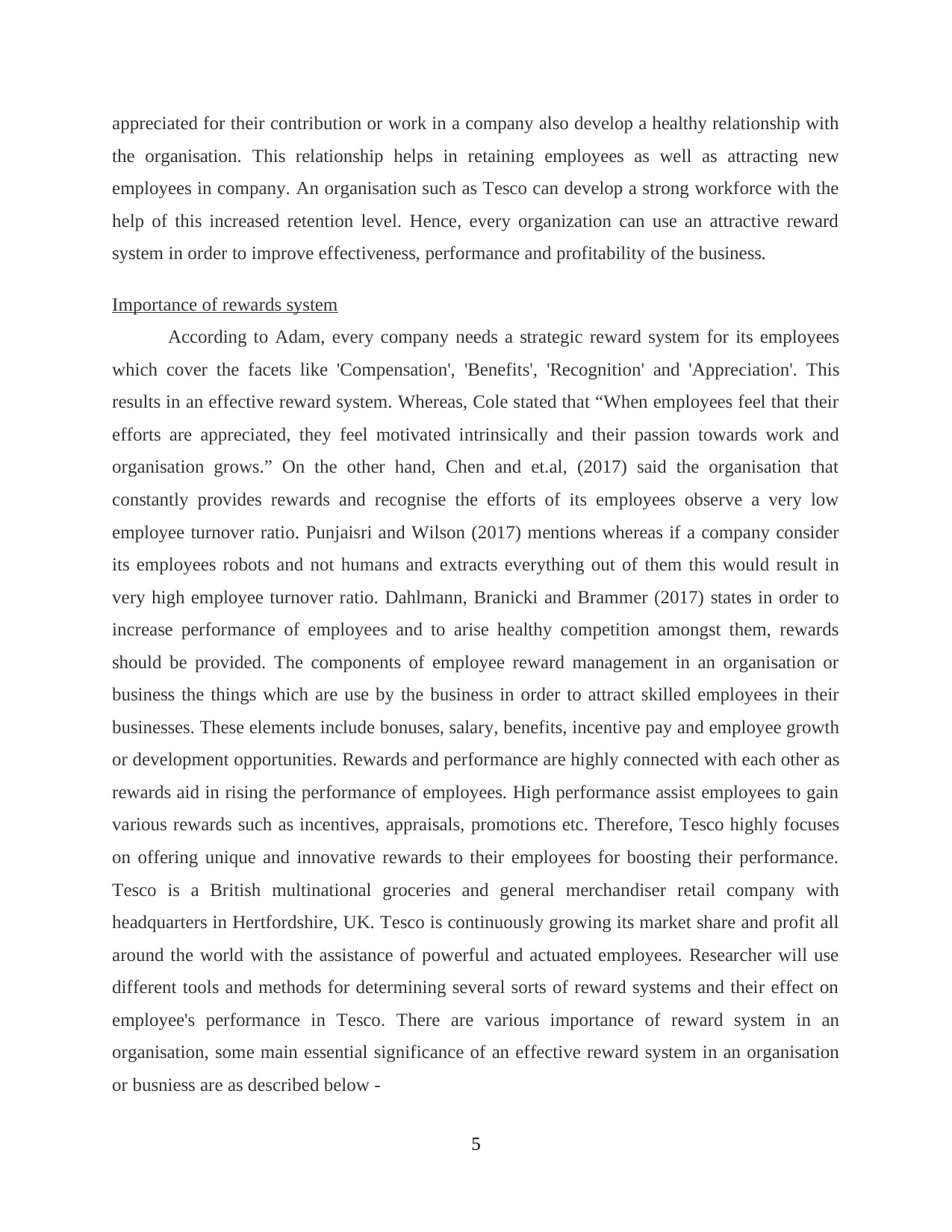
appreciated for their contribution or work in a company also develop a healthy relationship with
the organisation. This relationship helps in retaining employees as well as attracting new
employees in company. An organisation such as Tesco can develop a strong workforce with the
help of this increased retention level. Hence, every organization can use an attractive reward
system in order to improve effectiveness, performance and profitability of the business.
Importance of rewards system
According to Adam, every company needs a strategic reward system for its employees
which cover the facets like 'Compensation', 'Benefits', 'Recognition' and 'Appreciation'. This
results in an effective reward system. Whereas, Cole stated that “When employees feel that their
efforts are appreciated, they feel motivated intrinsically and their passion towards work and
organisation grows.” On the other hand, Chen and et.al, (2017) said the organisation that
constantly provides rewards and recognise the efforts of its employees observe a very low
employee turnover ratio. Punjaisri and Wilson (2017) mentions whereas if a company consider
its employees robots and not humans and extracts everything out of them this would result in
very high employee turnover ratio. Dahlmann, Branicki and Brammer (2017) states in order to
increase performance of employees and to arise healthy competition amongst them, rewards
should be provided. The components of employee reward management in an organisation or
business the things which are use by the business in order to attract skilled employees in their
businesses. These elements include bonuses, salary, benefits, incentive pay and employee growth
or development opportunities. Rewards and performance are highly connected with each other as
rewards aid in rising the performance of employees. High performance assist employees to gain
various rewards such as incentives, appraisals, promotions etc. Therefore, Tesco highly focuses
on offering unique and innovative rewards to their employees for boosting their performance.
Tesco is a British multinational groceries and general merchandiser retail company with
headquarters in Hertfordshire, UK. Tesco is continuously growing its market share and profit all
around the world with the assistance of powerful and actuated employees. Researcher will use
different tools and methods for determining several sorts of reward systems and their effect on
employee's performance in Tesco. There are various importance of reward system in an
organisation, some main essential significance of an effective reward system in an organisation
or busniess are as described below -
5
the organisation. This relationship helps in retaining employees as well as attracting new
employees in company. An organisation such as Tesco can develop a strong workforce with the
help of this increased retention level. Hence, every organization can use an attractive reward
system in order to improve effectiveness, performance and profitability of the business.
Importance of rewards system
According to Adam, every company needs a strategic reward system for its employees
which cover the facets like 'Compensation', 'Benefits', 'Recognition' and 'Appreciation'. This
results in an effective reward system. Whereas, Cole stated that “When employees feel that their
efforts are appreciated, they feel motivated intrinsically and their passion towards work and
organisation grows.” On the other hand, Chen and et.al, (2017) said the organisation that
constantly provides rewards and recognise the efforts of its employees observe a very low
employee turnover ratio. Punjaisri and Wilson (2017) mentions whereas if a company consider
its employees robots and not humans and extracts everything out of them this would result in
very high employee turnover ratio. Dahlmann, Branicki and Brammer (2017) states in order to
increase performance of employees and to arise healthy competition amongst them, rewards
should be provided. The components of employee reward management in an organisation or
business the things which are use by the business in order to attract skilled employees in their
businesses. These elements include bonuses, salary, benefits, incentive pay and employee growth
or development opportunities. Rewards and performance are highly connected with each other as
rewards aid in rising the performance of employees. High performance assist employees to gain
various rewards such as incentives, appraisals, promotions etc. Therefore, Tesco highly focuses
on offering unique and innovative rewards to their employees for boosting their performance.
Tesco is a British multinational groceries and general merchandiser retail company with
headquarters in Hertfordshire, UK. Tesco is continuously growing its market share and profit all
around the world with the assistance of powerful and actuated employees. Researcher will use
different tools and methods for determining several sorts of reward systems and their effect on
employee's performance in Tesco. There are various importance of reward system in an
organisation, some main essential significance of an effective reward system in an organisation
or busniess are as described below -
5
Paraphrase This Document
Need a fresh take? Get an instant paraphrase of this document with our AI Paraphraser
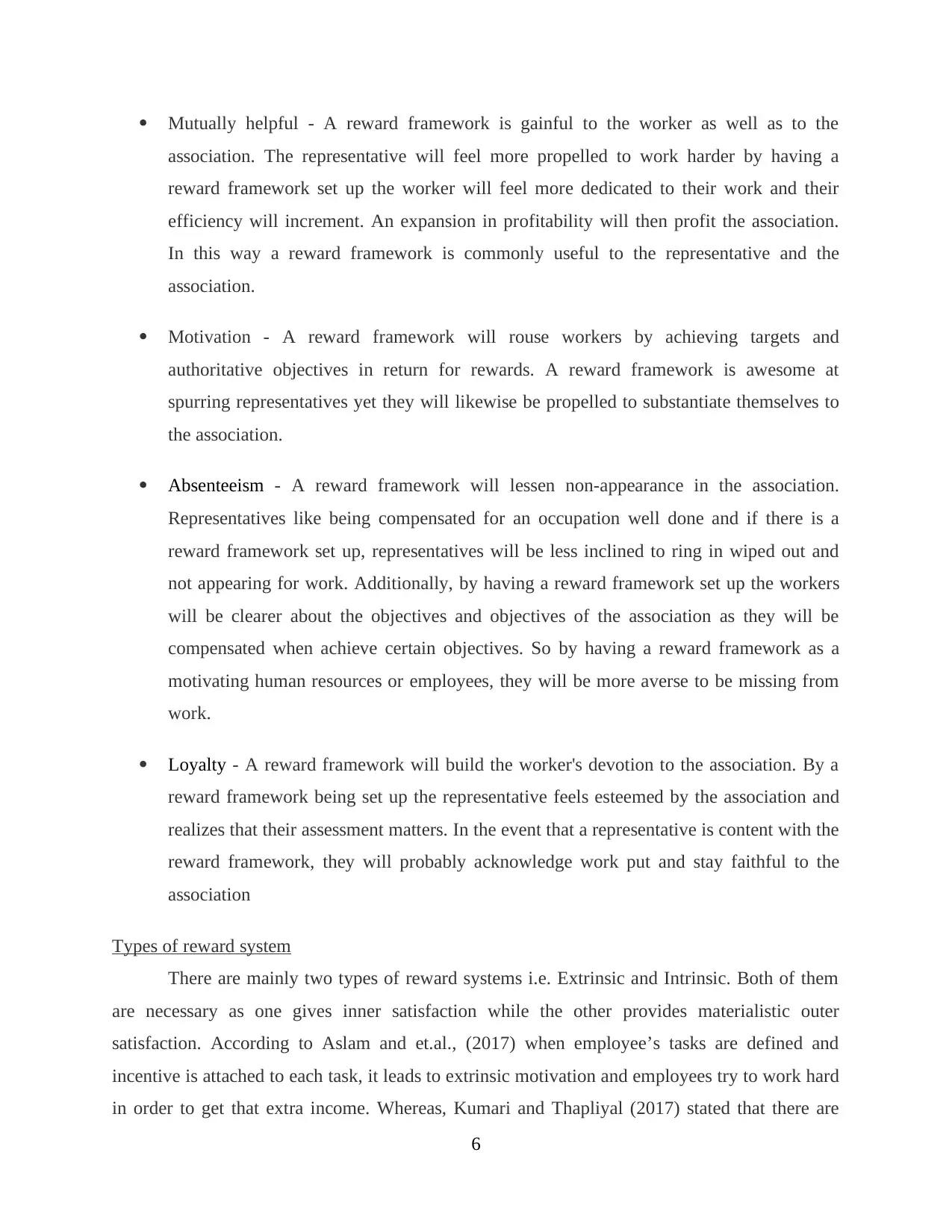
Mutually helpful - A reward framework is gainful to the worker as well as to the
association. The representative will feel more propelled to work harder by having a
reward framework set up the worker will feel more dedicated to their work and their
efficiency will increment. An expansion in profitability will then profit the association.
In this way a reward framework is commonly useful to the representative and the
association.
Motivation - A reward framework will rouse workers by achieving targets and
authoritative objectives in return for rewards. A reward framework is awesome at
spurring representatives yet they will likewise be propelled to substantiate themselves to
the association.
Absenteeism - A reward framework will lessen non-appearance in the association.
Representatives like being compensated for an occupation well done and if there is a
reward framework set up, representatives will be less inclined to ring in wiped out and
not appearing for work. Additionally, by having a reward framework set up the workers
will be clearer about the objectives and objectives of the association as they will be
compensated when achieve certain objectives. So by having a reward framework as a
motivating human resources or employees, they will be more averse to be missing from
work.
Loyalty - A reward framework will build the worker's devotion to the association. By a
reward framework being set up the representative feels esteemed by the association and
realizes that their assessment matters. In the event that a representative is content with the
reward framework, they will probably acknowledge work put and stay faithful to the
association
Types of reward system
There are mainly two types of reward systems i.e. Extrinsic and Intrinsic. Both of them
are necessary as one gives inner satisfaction while the other provides materialistic outer
satisfaction. According to Aslam and et.al., (2017) when employee’s tasks are defined and
incentive is attached to each task, it leads to extrinsic motivation and employees try to work hard
in order to get that extra income. Whereas, Kumari and Thapliyal (2017) stated that there are
6
association. The representative will feel more propelled to work harder by having a
reward framework set up the worker will feel more dedicated to their work and their
efficiency will increment. An expansion in profitability will then profit the association.
In this way a reward framework is commonly useful to the representative and the
association.
Motivation - A reward framework will rouse workers by achieving targets and
authoritative objectives in return for rewards. A reward framework is awesome at
spurring representatives yet they will likewise be propelled to substantiate themselves to
the association.
Absenteeism - A reward framework will lessen non-appearance in the association.
Representatives like being compensated for an occupation well done and if there is a
reward framework set up, representatives will be less inclined to ring in wiped out and
not appearing for work. Additionally, by having a reward framework set up the workers
will be clearer about the objectives and objectives of the association as they will be
compensated when achieve certain objectives. So by having a reward framework as a
motivating human resources or employees, they will be more averse to be missing from
work.
Loyalty - A reward framework will build the worker's devotion to the association. By a
reward framework being set up the representative feels esteemed by the association and
realizes that their assessment matters. In the event that a representative is content with the
reward framework, they will probably acknowledge work put and stay faithful to the
association
Types of reward system
There are mainly two types of reward systems i.e. Extrinsic and Intrinsic. Both of them
are necessary as one gives inner satisfaction while the other provides materialistic outer
satisfaction. According to Aslam and et.al., (2017) when employee’s tasks are defined and
incentive is attached to each task, it leads to extrinsic motivation and employees try to work hard
in order to get that extra income. Whereas, Kumari and Thapliyal (2017) stated that there are
6
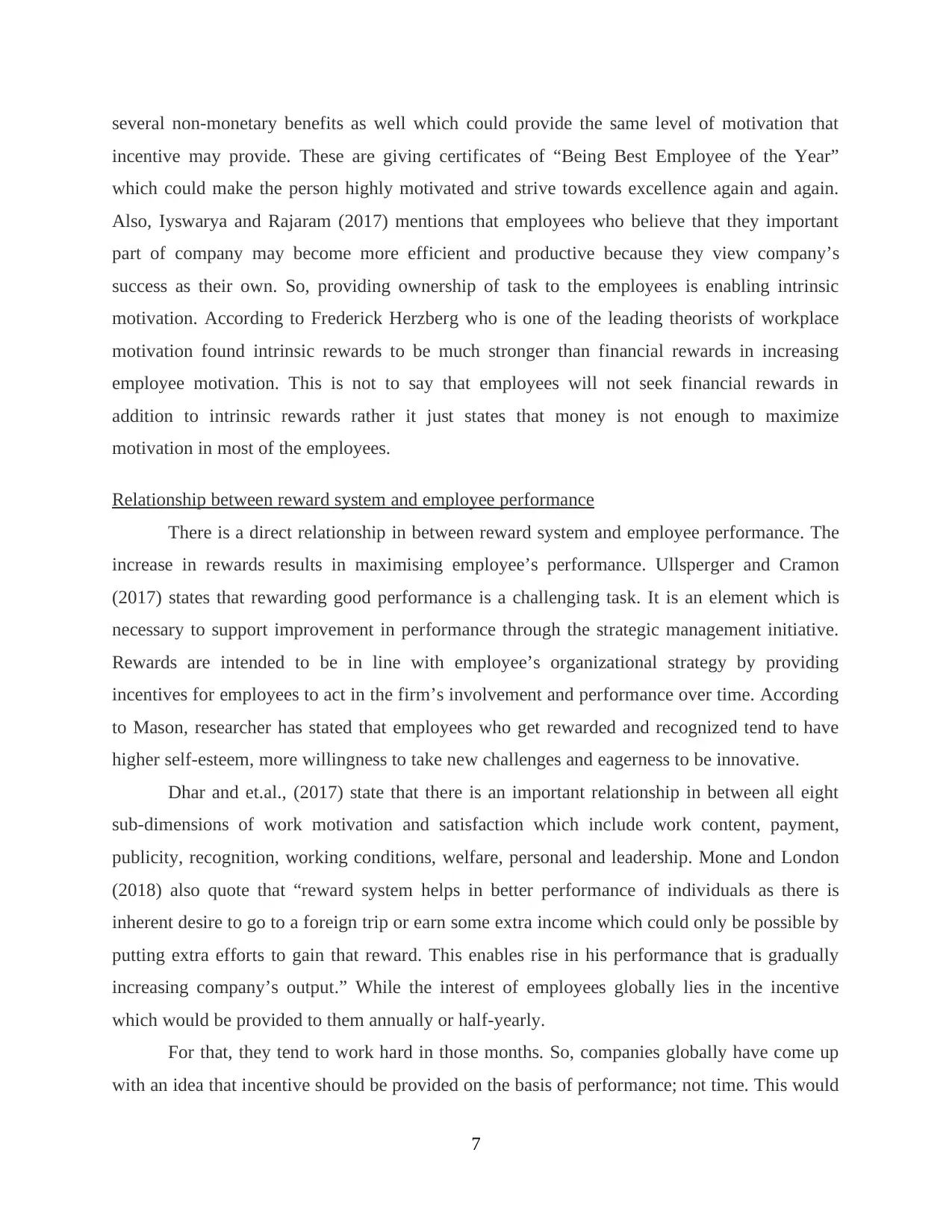
several non-monetary benefits as well which could provide the same level of motivation that
incentive may provide. These are giving certificates of “Being Best Employee of the Year”
which could make the person highly motivated and strive towards excellence again and again.
Also, Iyswarya and Rajaram (2017) mentions that employees who believe that they important
part of company may become more efficient and productive because they view company’s
success as their own. So, providing ownership of task to the employees is enabling intrinsic
motivation. According to Frederick Herzberg who is one of the leading theorists of workplace
motivation found intrinsic rewards to be much stronger than financial rewards in increasing
employee motivation. This is not to say that employees will not seek financial rewards in
addition to intrinsic rewards rather it just states that money is not enough to maximize
motivation in most of the employees.
Relationship between reward system and employee performance
There is a direct relationship in between reward system and employee performance. The
increase in rewards results in maximising employee’s performance. Ullsperger and Cramon
(2017) states that rewarding good performance is a challenging task. It is an element which is
necessary to support improvement in performance through the strategic management initiative.
Rewards are intended to be in line with employee’s organizational strategy by providing
incentives for employees to act in the firm’s involvement and performance over time. According
to Mason, researcher has stated that employees who get rewarded and recognized tend to have
higher self-esteem, more willingness to take new challenges and eagerness to be innovative.
Dhar and et.al., (2017) state that there is an important relationship in between all eight
sub-dimensions of work motivation and satisfaction which include work content, payment,
publicity, recognition, working conditions, welfare, personal and leadership. Mone and London
(2018) also quote that “reward system helps in better performance of individuals as there is
inherent desire to go to a foreign trip or earn some extra income which could only be possible by
putting extra efforts to gain that reward. This enables rise in his performance that is gradually
increasing company’s output.” While the interest of employees globally lies in the incentive
which would be provided to them annually or half-yearly.
For that, they tend to work hard in those months. So, companies globally have come up
with an idea that incentive should be provided on the basis of performance; not time. This would
7
incentive may provide. These are giving certificates of “Being Best Employee of the Year”
which could make the person highly motivated and strive towards excellence again and again.
Also, Iyswarya and Rajaram (2017) mentions that employees who believe that they important
part of company may become more efficient and productive because they view company’s
success as their own. So, providing ownership of task to the employees is enabling intrinsic
motivation. According to Frederick Herzberg who is one of the leading theorists of workplace
motivation found intrinsic rewards to be much stronger than financial rewards in increasing
employee motivation. This is not to say that employees will not seek financial rewards in
addition to intrinsic rewards rather it just states that money is not enough to maximize
motivation in most of the employees.
Relationship between reward system and employee performance
There is a direct relationship in between reward system and employee performance. The
increase in rewards results in maximising employee’s performance. Ullsperger and Cramon
(2017) states that rewarding good performance is a challenging task. It is an element which is
necessary to support improvement in performance through the strategic management initiative.
Rewards are intended to be in line with employee’s organizational strategy by providing
incentives for employees to act in the firm’s involvement and performance over time. According
to Mason, researcher has stated that employees who get rewarded and recognized tend to have
higher self-esteem, more willingness to take new challenges and eagerness to be innovative.
Dhar and et.al., (2017) state that there is an important relationship in between all eight
sub-dimensions of work motivation and satisfaction which include work content, payment,
publicity, recognition, working conditions, welfare, personal and leadership. Mone and London
(2018) also quote that “reward system helps in better performance of individuals as there is
inherent desire to go to a foreign trip or earn some extra income which could only be possible by
putting extra efforts to gain that reward. This enables rise in his performance that is gradually
increasing company’s output.” While the interest of employees globally lies in the incentive
which would be provided to them annually or half-yearly.
For that, they tend to work hard in those months. So, companies globally have come up
with an idea that incentive should be provided on the basis of performance; not time. This would
7
⊘ This is a preview!⊘
Do you want full access?
Subscribe today to unlock all pages.

Trusted by 1+ million students worldwide
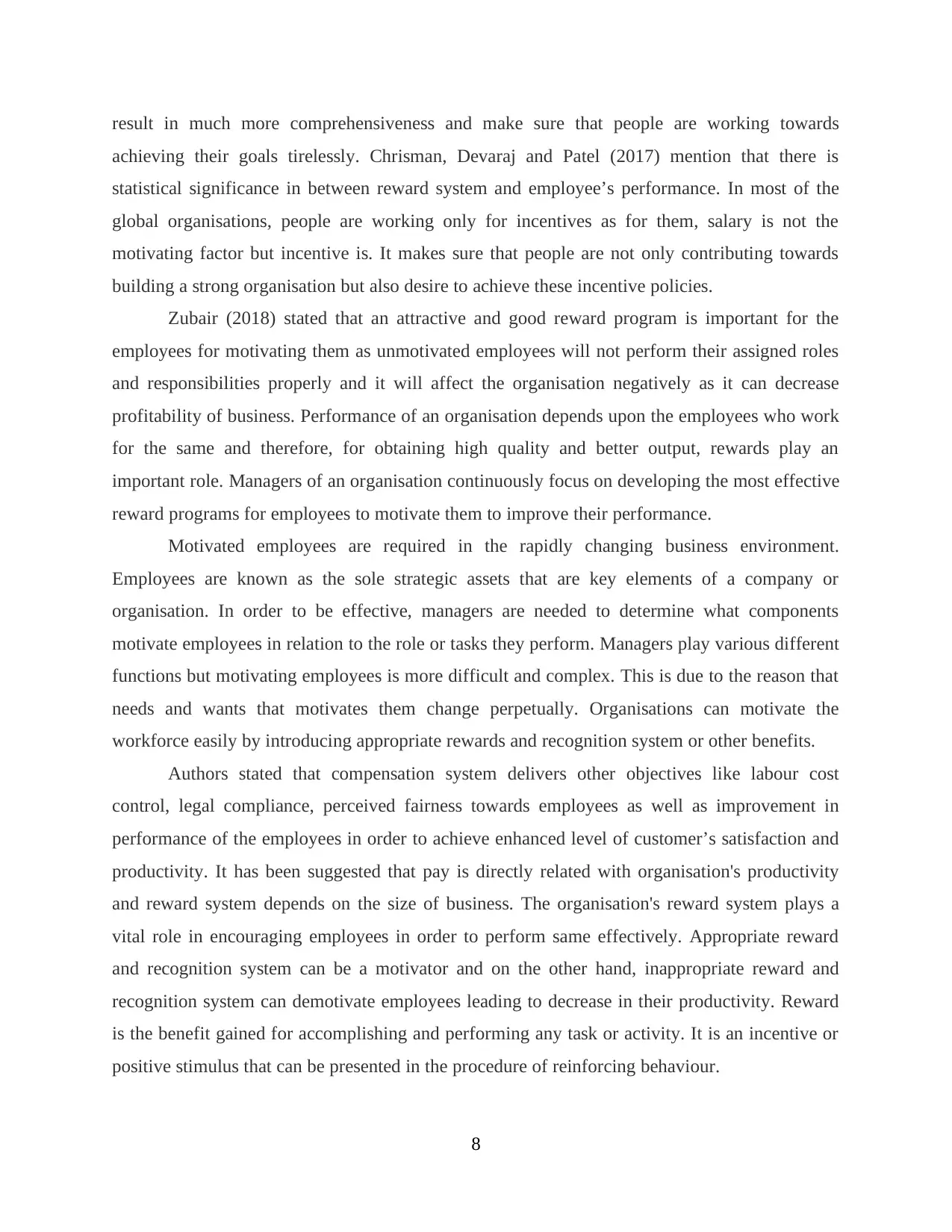
result in much more comprehensiveness and make sure that people are working towards
achieving their goals tirelessly. Chrisman, Devaraj and Patel (2017) mention that there is
statistical significance in between reward system and employee’s performance. In most of the
global organisations, people are working only for incentives as for them, salary is not the
motivating factor but incentive is. It makes sure that people are not only contributing towards
building a strong organisation but also desire to achieve these incentive policies.
Zubair (2018) stated that an attractive and good reward program is important for the
employees for motivating them as unmotivated employees will not perform their assigned roles
and responsibilities properly and it will affect the organisation negatively as it can decrease
profitability of business. Performance of an organisation depends upon the employees who work
for the same and therefore, for obtaining high quality and better output, rewards play an
important role. Managers of an organisation continuously focus on developing the most effective
reward programs for employees to motivate them to improve their performance.
Motivated employees are required in the rapidly changing business environment.
Employees are known as the sole strategic assets that are key elements of a company or
organisation. In order to be effective, managers are needed to determine what components
motivate employees in relation to the role or tasks they perform. Managers play various different
functions but motivating employees is more difficult and complex. This is due to the reason that
needs and wants that motivates them change perpetually. Organisations can motivate the
workforce easily by introducing appropriate rewards and recognition system or other benefits.
Authors stated that compensation system delivers other objectives like labour cost
control, legal compliance, perceived fairness towards employees as well as improvement in
performance of the employees in order to achieve enhanced level of customer’s satisfaction and
productivity. It has been suggested that pay is directly related with organisation's productivity
and reward system depends on the size of business. The organisation's reward system plays a
vital role in encouraging employees in order to perform same effectively. Appropriate reward
and recognition system can be a motivator and on the other hand, inappropriate reward and
recognition system can demotivate employees leading to decrease in their productivity. Reward
is the benefit gained for accomplishing and performing any task or activity. It is an incentive or
positive stimulus that can be presented in the procedure of reinforcing behaviour.
8
achieving their goals tirelessly. Chrisman, Devaraj and Patel (2017) mention that there is
statistical significance in between reward system and employee’s performance. In most of the
global organisations, people are working only for incentives as for them, salary is not the
motivating factor but incentive is. It makes sure that people are not only contributing towards
building a strong organisation but also desire to achieve these incentive policies.
Zubair (2018) stated that an attractive and good reward program is important for the
employees for motivating them as unmotivated employees will not perform their assigned roles
and responsibilities properly and it will affect the organisation negatively as it can decrease
profitability of business. Performance of an organisation depends upon the employees who work
for the same and therefore, for obtaining high quality and better output, rewards play an
important role. Managers of an organisation continuously focus on developing the most effective
reward programs for employees to motivate them to improve their performance.
Motivated employees are required in the rapidly changing business environment.
Employees are known as the sole strategic assets that are key elements of a company or
organisation. In order to be effective, managers are needed to determine what components
motivate employees in relation to the role or tasks they perform. Managers play various different
functions but motivating employees is more difficult and complex. This is due to the reason that
needs and wants that motivates them change perpetually. Organisations can motivate the
workforce easily by introducing appropriate rewards and recognition system or other benefits.
Authors stated that compensation system delivers other objectives like labour cost
control, legal compliance, perceived fairness towards employees as well as improvement in
performance of the employees in order to achieve enhanced level of customer’s satisfaction and
productivity. It has been suggested that pay is directly related with organisation's productivity
and reward system depends on the size of business. The organisation's reward system plays a
vital role in encouraging employees in order to perform same effectively. Appropriate reward
and recognition system can be a motivator and on the other hand, inappropriate reward and
recognition system can demotivate employees leading to decrease in their productivity. Reward
is the benefit gained for accomplishing and performing any task or activity. It is an incentive or
positive stimulus that can be presented in the procedure of reinforcing behaviour.
8
Paraphrase This Document
Need a fresh take? Get an instant paraphrase of this document with our AI Paraphraser
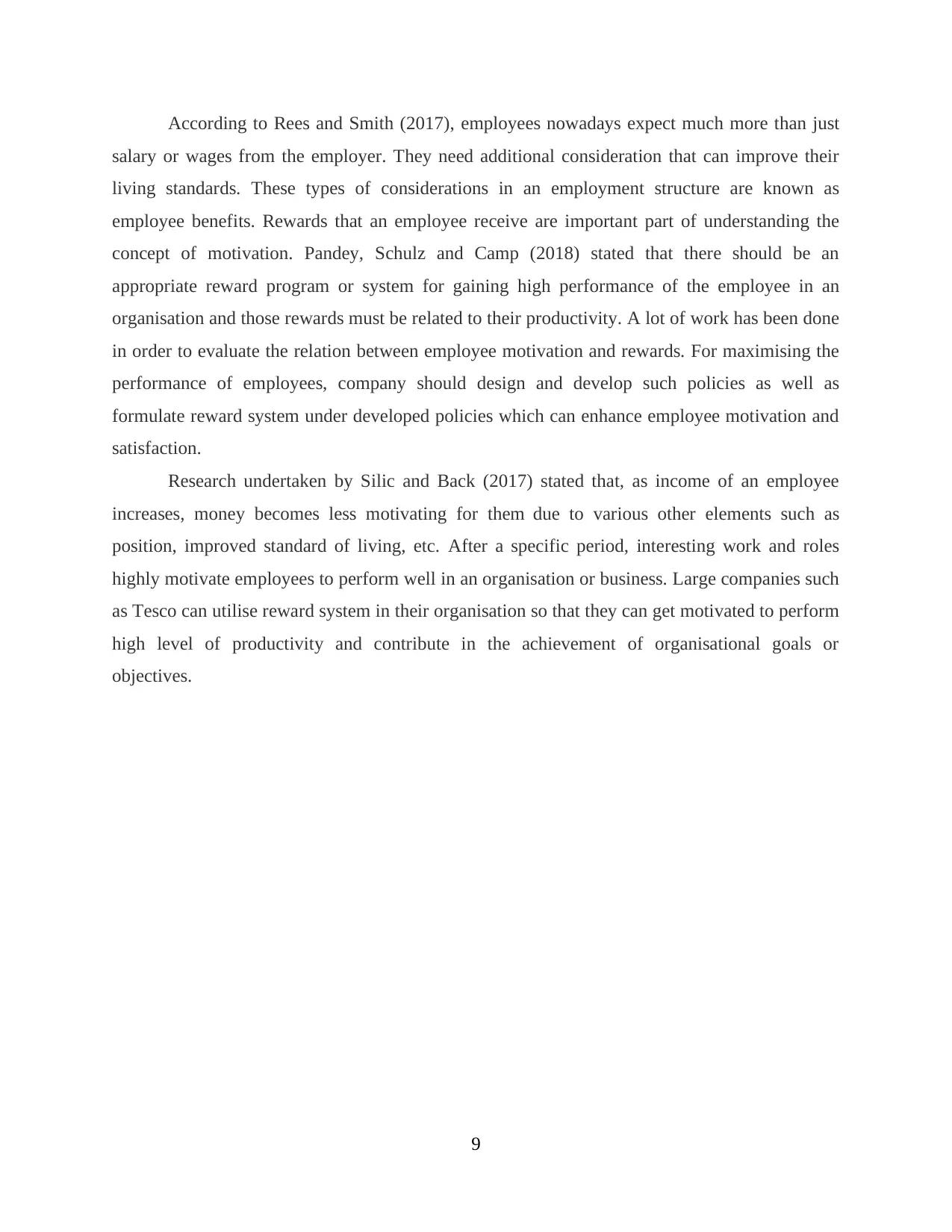
According to Rees and Smith (2017), employees nowadays expect much more than just
salary or wages from the employer. They need additional consideration that can improve their
living standards. These types of considerations in an employment structure are known as
employee benefits. Rewards that an employee receive are important part of understanding the
concept of motivation. Pandey, Schulz and Camp (2018) stated that there should be an
appropriate reward program or system for gaining high performance of the employee in an
organisation and those rewards must be related to their productivity. A lot of work has been done
in order to evaluate the relation between employee motivation and rewards. For maximising the
performance of employees, company should design and develop such policies as well as
formulate reward system under developed policies which can enhance employee motivation and
satisfaction.
Research undertaken by Silic and Back (2017) stated that, as income of an employee
increases, money becomes less motivating for them due to various other elements such as
position, improved standard of living, etc. After a specific period, interesting work and roles
highly motivate employees to perform well in an organisation or business. Large companies such
as Tesco can utilise reward system in their organisation so that they can get motivated to perform
high level of productivity and contribute in the achievement of organisational goals or
objectives.
9
salary or wages from the employer. They need additional consideration that can improve their
living standards. These types of considerations in an employment structure are known as
employee benefits. Rewards that an employee receive are important part of understanding the
concept of motivation. Pandey, Schulz and Camp (2018) stated that there should be an
appropriate reward program or system for gaining high performance of the employee in an
organisation and those rewards must be related to their productivity. A lot of work has been done
in order to evaluate the relation between employee motivation and rewards. For maximising the
performance of employees, company should design and develop such policies as well as
formulate reward system under developed policies which can enhance employee motivation and
satisfaction.
Research undertaken by Silic and Back (2017) stated that, as income of an employee
increases, money becomes less motivating for them due to various other elements such as
position, improved standard of living, etc. After a specific period, interesting work and roles
highly motivate employees to perform well in an organisation or business. Large companies such
as Tesco can utilise reward system in their organisation so that they can get motivated to perform
high level of productivity and contribute in the achievement of organisational goals or
objectives.
9
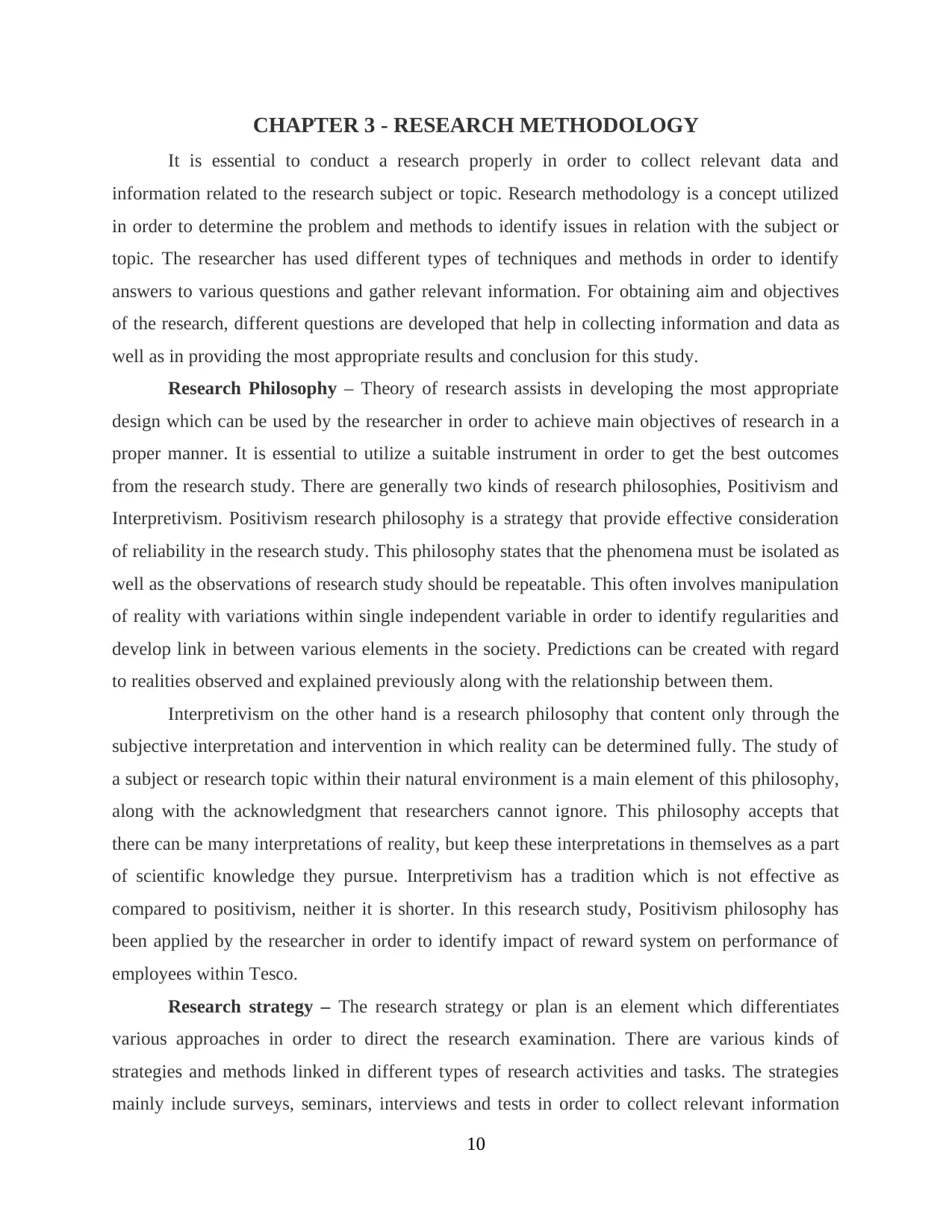
CHAPTER 3 - RESEARCH METHODOLOGY
It is essential to conduct a research properly in order to collect relevant data and
information related to the research subject or topic. Research methodology is a concept utilized
in order to determine the problem and methods to identify issues in relation with the subject or
topic. The researcher has used different types of techniques and methods in order to identify
answers to various questions and gather relevant information. For obtaining aim and objectives
of the research, different questions are developed that help in collecting information and data as
well as in providing the most appropriate results and conclusion for this study.
Research Philosophy – Theory of research assists in developing the most appropriate
design which can be used by the researcher in order to achieve main objectives of research in a
proper manner. It is essential to utilize a suitable instrument in order to get the best outcomes
from the research study. There are generally two kinds of research philosophies, Positivism and
Interpretivism. Positivism research philosophy is a strategy that provide effective consideration
of reliability in the research study. This philosophy states that the phenomena must be isolated as
well as the observations of research study should be repeatable. This often involves manipulation
of reality with variations within single independent variable in order to identify regularities and
develop link in between various elements in the society. Predictions can be created with regard
to realities observed and explained previously along with the relationship between them.
Interpretivism on the other hand is a research philosophy that content only through the
subjective interpretation and intervention in which reality can be determined fully. The study of
a subject or research topic within their natural environment is a main element of this philosophy,
along with the acknowledgment that researchers cannot ignore. This philosophy accepts that
there can be many interpretations of reality, but keep these interpretations in themselves as a part
of scientific knowledge they pursue. Interpretivism has a tradition which is not effective as
compared to positivism, neither it is shorter. In this research study, Positivism philosophy has
been applied by the researcher in order to identify impact of reward system on performance of
employees within Tesco.
Research strategy – The research strategy or plan is an element which differentiates
various approaches in order to direct the research examination. There are various kinds of
strategies and methods linked in different types of research activities and tasks. The strategies
mainly include surveys, seminars, interviews and tests in order to collect relevant information
10
It is essential to conduct a research properly in order to collect relevant data and
information related to the research subject or topic. Research methodology is a concept utilized
in order to determine the problem and methods to identify issues in relation with the subject or
topic. The researcher has used different types of techniques and methods in order to identify
answers to various questions and gather relevant information. For obtaining aim and objectives
of the research, different questions are developed that help in collecting information and data as
well as in providing the most appropriate results and conclusion for this study.
Research Philosophy – Theory of research assists in developing the most appropriate
design which can be used by the researcher in order to achieve main objectives of research in a
proper manner. It is essential to utilize a suitable instrument in order to get the best outcomes
from the research study. There are generally two kinds of research philosophies, Positivism and
Interpretivism. Positivism research philosophy is a strategy that provide effective consideration
of reliability in the research study. This philosophy states that the phenomena must be isolated as
well as the observations of research study should be repeatable. This often involves manipulation
of reality with variations within single independent variable in order to identify regularities and
develop link in between various elements in the society. Predictions can be created with regard
to realities observed and explained previously along with the relationship between them.
Interpretivism on the other hand is a research philosophy that content only through the
subjective interpretation and intervention in which reality can be determined fully. The study of
a subject or research topic within their natural environment is a main element of this philosophy,
along with the acknowledgment that researchers cannot ignore. This philosophy accepts that
there can be many interpretations of reality, but keep these interpretations in themselves as a part
of scientific knowledge they pursue. Interpretivism has a tradition which is not effective as
compared to positivism, neither it is shorter. In this research study, Positivism philosophy has
been applied by the researcher in order to identify impact of reward system on performance of
employees within Tesco.
Research strategy – The research strategy or plan is an element which differentiates
various approaches in order to direct the research examination. There are various kinds of
strategies and methods linked in different types of research activities and tasks. The strategies
mainly include surveys, seminars, interviews and tests in order to collect relevant information
10
⊘ This is a preview!⊘
Do you want full access?
Subscribe today to unlock all pages.

Trusted by 1+ million students worldwide
1 out of 41
Related Documents
Your All-in-One AI-Powered Toolkit for Academic Success.
+13062052269
info@desklib.com
Available 24*7 on WhatsApp / Email
![[object Object]](/_next/static/media/star-bottom.7253800d.svg)
Unlock your academic potential
Copyright © 2020–2025 A2Z Services. All Rights Reserved. Developed and managed by ZUCOL.





